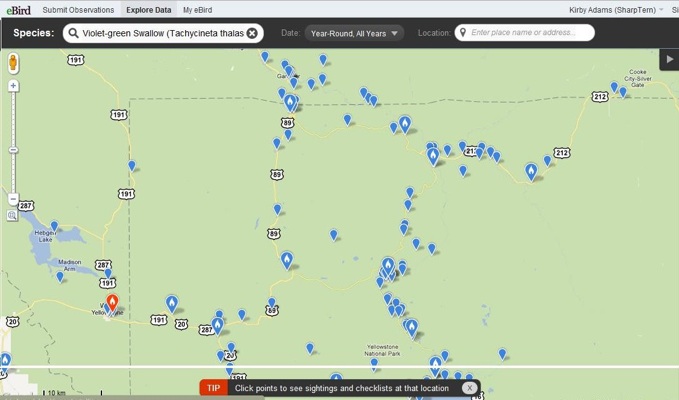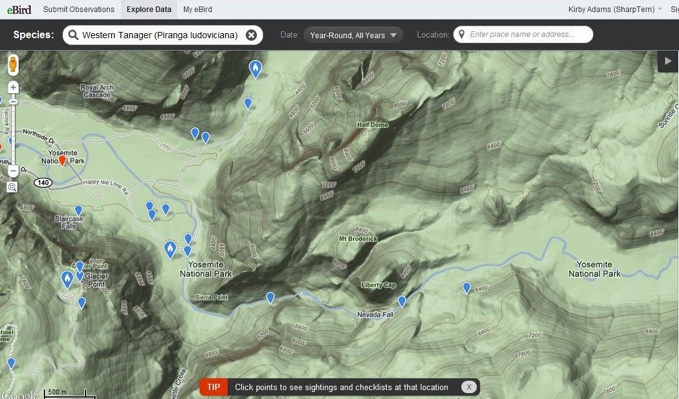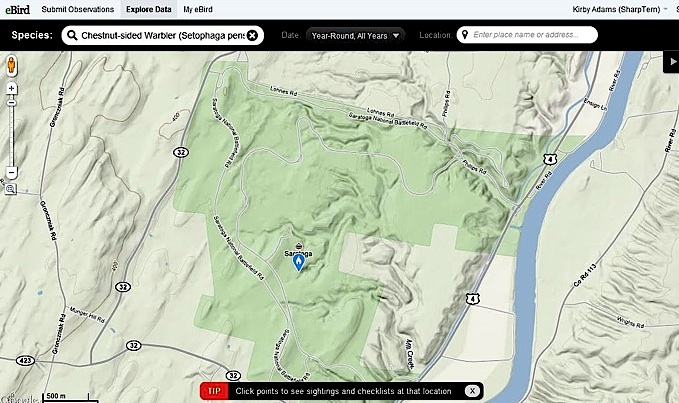Citizen scientist. Even in the age of instantly uploadable and downloadable data, that term can seem an oxymoron to citizens and scientists alike.
Thanks to the Cornell Lab of Ornithology and the National Audubon Society, it’s becoming easier for even a casual bird-watcher to contribute to the collective knowledge of the fields of ornithology and ecology.
Launched in 2002, eBird is, at its simplest, a web-based checklist for birders to keep track of their sightings. On a grander scale it’s a collection of data about bird biodiversity collected by millions of people around the world that is then available to any researcher who’d like to access it.
Think about it. You’re hiking or driving through Joshua Tree National Park and you spot a bright yellow bird with a black head picking at some agave fruit. Even if you’re a novice birder and this is your first trip to the southwest, the field guide you picked up in the visitor’s center will help you easily identify this bird as a Scott’s Oriole (Icterus parisorum).
You are now the proud owner of some ornithological data: the date, time, location, and behavior of a particular bird. No one else was around to see this bird at this particular time and place, so you are the only person in the world possessing these exact data.
Feeling the pressure of responsibility yet? If you’ve signed up at eBird, you can enter those data today, or when your vacation is over, and the next time an ornithologist is comparing migration and abundance of orioles in the southwest as the climate warms, your data will be part of the study.
To paraphrase a somewhat popular movie, “You’re a scientist, Harry!”
Sound too easy? Worried that you’ll misidentify a bird? Relax. There’s an understood amount of error in any data collection or reporting and the people using eBird’s data factor that into their studies. There’s also a built-in, volunteer-powered review process in place just in case you report the sighting of something outrageous.
Think you saw an Atlantic Puffin perched on a cactus a little further down the road in Joshua Tree? Someone from eBird will ask for photographic confirmation before they enter that sighting in the record. If you absolutely swear you saw the puffin, it can stay on your personal life-list, but it won’t be available to researchers without some proof.
Let’s take a look at the National Parks and eBird.
I once spotted a gorgeous Violet-green Swallow (Tachycineta thalassina) in Yellowstone National Park as a neophyte birder. I think this guy made me realize I was destined to be a dedicated bird-nerd when I caught myself devoting all my attention to this character while the assembled crowd was facing the opposite direction to admire the grandeur of Tower Fall.
I was curious how common these birds were in Yellowstone, so I typed the name into eBird and here’s what it tells me:

It's easy to track Violet-green swallows in Yellowstone with eBird. Map courtesy of eBird.
Looks like a lot of people have seen Violet-green swallows in the park. Each blue dot is a bird checklist submitted by someone who includes this type of bird.
The blue markers with a flame indicate that that spot is a “hotspot” that has multiple checklists with the bird in question.
What can we gather from this map? Apparently most birders, like everyone else, sticks to the loop roads when visiting Yellowstone. I’d call that an opportunity. The next time you’re a mile or more off the roads, you’ll be staying alert for grizzly bears and looking for Violet-green swallows. It’s a common bird and we can all presume it’s present in the backcountry, but every reported sighting only helps to flesh out the whole story.
eBird just becomes a better and better and tool with each and every additional upload of data.
Has anyone spotted the gorgeous Western Tanager (Piranga ludoviciana) while experiencing the breathtaking scenery along Yosemite National Park’s famous Mist Trail?

Apparently not many Western tanagers appreciate the Mist Trail in Yosemite National Park. Map courtesy of eBird.
Apparently not! There are only a couple checklists from that area, and none from popular spots like the top of Vernal Fall.
If I can record a nifty Violet-green swallow at Tower Fall, someone can easily see a Western tanager while taking a break from Vernal Fall. This map also tells me that no one is bird-watching while climbing the cables at Half Dome, which even a hardcore birder has to admit is a smart move.
Safety first, even if you think you see a rare bird!
Let’s not forget that the National Park System has nearly 400 units and every one of them is birdable. Do you think a relatively common eastern songbird like the Chestnut-sided Warbler (Setophaga pensylvanica) is reported much in Saratoga National Historical Park, just up the road from Albany, New York?

There might be quite a few Chestnut-sided warblers in Saratoga National Historical Park, but not too many people have seen them. Map courtesy of eBird.
Again, it appears the answer is: not too often and not with high precision of location.
The marker in the middle of the park indicates that several checklists for the park include this bird, but all of the checklists are just centered in the park and not highly specific to location.
It improves the quality of the data significantly when the sightings are as specific as possible. Since there aren’t any cannons firing over the Hudson Valley like there were in 1777, you can take your time and report all the birds you see in the trees near the river and put your marker right on the spot where you stood.
The birding hobby’s greatest reward has always been personal satisfaction. There’s nothing that brightens your day like adding another tick to the life list. But when you can store that life-list somewhere where it contributes to the greater good of science, the satisfaction is that much greater.
The ornithologists out there thank you for using eBird, and when their work leads to new advances and ideas in conservation, the birds will thank you as well.
Traveler postscript: Do you already use eBird to track your birding successes? Is it a valuable tool?
There is a smartphone app that works with eBird, called BirdsEye, though it's not free. Pricing is $1.99 for "BirdsEye Light" for those new to birding (it covers only 135 species), and $19.99 for the full-fledged version that covers 857 species and which provides "recent reports of truly rare birds throughout North America, as well as notable reports that are unexpected and significant locally."


 Support Essential Coverage of Essential Places
Support Essential Coverage of Essential Places






